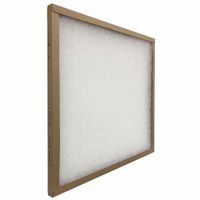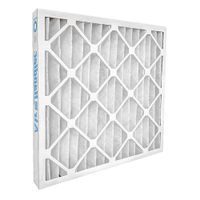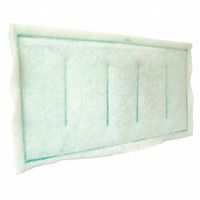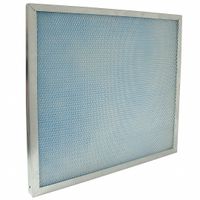Call +(254) 703 030 000 / 751 483 999 / 721 704 777
- Home
- Hvac And Refrigeration
- Air Filters
- Panel And Pleated Air Filters
.....Read More
Frequently Asked Questions
What is the difference between panel and pleated air filters?
Panel air filters and pleated air filters differ primarily in design, efficiency, and application.
Panel air filters are typically flat and consist of a single layer of filtering material, often made from fiberglass or polyester. They are designed for basic filtration, capturing larger particles like dust and lint. Due to their simple construction, panel filters are generally less expensive and have a lower initial resistance to airflow, which can be beneficial for systems requiring high airflow rates. However, they have a lower dust-holding capacity and need to be replaced more frequently.
Pleated air filters, on the other hand, have a folded or pleated design that increases the surface area of the filter material. This design allows them to capture smaller particles, including pollen, mold spores, and pet dander, making them more efficient than panel filters. The increased surface area also enhances their dust-holding capacity, meaning they can last longer before needing replacement. Pleated filters are often made from higher-quality materials, such as cotton or synthetic blends, and are available in various MERV (Minimum Efficiency Reporting Value) ratings, which indicate their efficiency in trapping particles of different sizes.
In summary, panel filters are suitable for basic filtration needs and are cost-effective, while pleated filters offer higher efficiency and better air quality, making them ideal for environments where improved indoor air quality is a priority.
How often should panel and pleated air filters be replaced?
Panel and pleated air filters should generally be replaced every 1 to 3 months. However, the exact frequency depends on several factors:
1. **Type of Filter**: Pleated filters, which are more efficient at capturing particles, may last longer than basic panel filters. High-efficiency pleated filters might need replacement every 3 months, while standard panel filters might require more frequent changes.
2. **Usage**: If the HVAC system is used frequently, such as in extreme weather conditions, filters may need to be replaced more often.
3. **Environment**: Homes in areas with high levels of dust, pollution, or pollen may require more frequent filter changes. Similarly, homes with pets or smokers will likely need to replace filters more often due to increased debris and odor particles.
4. **Allergies or Respiratory Issues**: In households with individuals who have allergies or respiratory conditions, more frequent filter changes can help maintain better air quality.
5. **Manufacturer’s Recommendations**: Always check the filter packaging or manufacturer’s guidelines for specific replacement intervals.
6. **Visual Inspection**: Regularly inspect filters for visible dirt and debris. If the filter appears clogged or discolored, it should be replaced regardless of the time since the last change.
7. **System Performance**: If the HVAC system is not heating or cooling efficiently, or if there is a noticeable decrease in air quality, it may be time to replace the filter.
By considering these factors, you can determine the optimal replacement schedule for your specific situation, ensuring efficient HVAC operation and maintaining good indoor air quality.
What MERV rating should I look for in panel and pleated air filters?
When selecting a MERV (Minimum Efficiency Reporting Value) rating for panel and pleated air filters, consider the following:
1. **Purpose and Environment**:
- **Residential Use**: For typical home environments, a MERV rating between 6 and 8 is often sufficient. These filters capture common household particles like dust, pollen, and mold spores.
- **Enhanced Air Quality**: If you have allergies or respiratory issues, consider a MERV rating between 9 and 12. These filters can capture finer particles, including pet dander and finer dust.
- **High Efficiency**: For environments requiring superior air quality, such as homes with smokers or those near construction sites, a MERV rating of 13 to 16 is recommended. These filters can capture bacteria and smoke particles.
2. **HVAC System Compatibility**:
- Ensure your HVAC system can handle the airflow resistance of higher MERV-rated filters. High MERV filters can restrict airflow, potentially reducing system efficiency or causing damage if the system is not designed for them.
3. **Cost and Maintenance**:
- Higher MERV filters are generally more expensive and may require more frequent replacement. Balance the cost with the level of air quality you need.
4. **Specific Needs**:
- Consider any specific needs, such as pet ownership, allergies, or living in a high-pollution area, which might necessitate a higher MERV rating.
5. **Regulations and Recommendations**:
- Check any local regulations or recommendations, especially for commercial or public buildings, which might dictate minimum MERV ratings.
In summary, choose a MERV rating that balances air quality needs with HVAC system capabilities and maintenance considerations. For most residential settings, a MERV rating between 8 and 12 is adequate, while higher ratings are suitable for specific needs or environments.
Can panel and pleated air filters improve indoor air quality?
Yes, panel and pleated air filters can improve indoor air quality. These filters are designed to capture airborne particles, including dust, pollen, mold spores, and other contaminants, thereby reducing the concentration of these pollutants in indoor environments.
Panel air filters are typically flat and consist of a single layer of filtering material. They are effective at capturing larger particles and are commonly used in HVAC systems. While they are less efficient than pleated filters, they still contribute to improved air quality by removing some of the larger particulates from the air.
Pleated air filters, on the other hand, have a greater surface area due to their pleated design, which allows them to capture smaller particles more effectively. The increased surface area also means they can hold more particles before needing replacement, making them more efficient over time. Pleated filters are available in various MERV (Minimum Efficiency Reporting Value) ratings, which indicate their ability to capture different sizes of particles. Higher MERV ratings correspond to better filtration efficiency.
By using these filters, indoor air quality can be significantly enhanced, leading to a reduction in respiratory issues, allergies, and other health problems associated with poor air quality. They also help in maintaining cleaner HVAC systems, which can improve energy efficiency and prolong the lifespan of the equipment.
However, it is important to regularly replace or clean these filters to maintain their effectiveness. The frequency of replacement depends on factors such as the type of filter, the level of indoor pollution, and the specific needs of the occupants. In summary, both panel and pleated air filters play a crucial role in improving indoor air quality by effectively capturing airborne pollutants.
Are pleated air filters better than non-pleated ones?
Pleated air filters are generally considered better than non-pleated ones for several reasons. Firstly, pleated filters have a larger surface area due to their folded design, which allows them to capture more particles and contaminants from the air. This increased surface area enhances their efficiency in trapping dust, pollen, mold spores, and other airborne particles, leading to improved indoor air quality.
Secondly, pleated filters typically have a higher Minimum Efficiency Reporting Value (MERV) rating compared to non-pleated filters. A higher MERV rating indicates better filtration performance, meaning pleated filters can capture smaller particles more effectively. This makes them suitable for environments where air quality is a priority, such as homes with allergy sufferers or in areas with high pollution levels.
Additionally, pleated filters tend to have a longer lifespan than non-pleated filters. The increased surface area not only improves filtration efficiency but also allows the filter to hold more dirt before it needs replacement. This can result in cost savings over time, as pleated filters may not need to be changed as frequently as their non-pleated counterparts.
However, pleated filters can be more expensive upfront than non-pleated filters. They may also create more resistance to airflow, which can put additional strain on HVAC systems if not properly matched to the system's specifications. It's important to choose a pleated filter with the appropriate MERV rating for your system to avoid any potential issues.
In summary, pleated air filters offer superior filtration efficiency, better air quality, and longer lifespan compared to non-pleated filters, making them a preferred choice for many applications, despite their higher initial cost and potential impact on airflow.
How do I know if my HVAC system is compatible with panel and pleated air filters?
To determine if your HVAC system is compatible with panel and pleated air filters, follow these steps:
1. **Check the Manufacturer's Manual**: Refer to the HVAC system's manual or documentation. It often specifies the types of filters that are compatible with your system.
2. **Inspect the Filter Slot**: Measure the dimensions of the filter slot in your HVAC system. Panel and pleated filters come in standard sizes, so ensure the filter you choose fits the slot.
3. **Consider the MERV Rating**: The Minimum Efficiency Reporting Value (MERV) rating indicates a filter's efficiency. Check your system's manual for the recommended MERV rating. Most residential systems can handle filters with a MERV rating between 6 and 12. Higher MERV ratings may restrict airflow if the system isn't designed for them.
4. **Assess Airflow Requirements**: Pleated filters, due to their design, can restrict airflow more than panel filters. Ensure your system can handle the reduced airflow without compromising performance. Consult a professional if unsure.
5. **Examine System Age and Condition**: Older systems may not be designed for high-efficiency filters. If your system is older, it might be better suited for lower MERV-rated panel filters.
6. **Consult a Professional**: If in doubt, consult an HVAC technician. They can assess your system and recommend suitable filter types.
7. **Trial and Observation**: After installing a new filter type, monitor your system's performance. Look for signs of strain, such as unusual noises or reduced efficiency, which may indicate incompatibility.
By following these steps, you can determine if your HVAC system is compatible with panel and pleated air filters, ensuring optimal performance and air quality.
What are the benefits of using panel and pleated air filters in HVAC systems?
Panel and pleated air filters in HVAC systems offer several benefits:
1. **Improved Air Quality**: Both panel and pleated filters capture dust, pollen, mold spores, and other airborne particles, enhancing indoor air quality. Pleated filters, with their increased surface area, are particularly effective at trapping smaller particles.
2. **Energy Efficiency**: By maintaining cleaner air, these filters help HVAC systems operate more efficiently. Clean filters reduce the strain on the system, potentially lowering energy consumption and utility bills.
3. **Extended HVAC Lifespan**: Regular use of panel and pleated filters can prevent dust and debris from accumulating in the HVAC system, reducing wear and tear and extending the system's lifespan.
4. **Cost-Effectiveness**: While pleated filters may have a higher initial cost than panel filters, their efficiency in capturing particles can lead to less frequent replacements and maintenance, offering long-term savings.
5. **Versatility**: Available in various sizes and MERV ratings, panel and pleated filters can be tailored to specific needs, from basic residential use to more demanding commercial applications.
6. **Allergen Reduction**: Pleated filters, in particular, are effective at reducing allergens, benefiting individuals with allergies or respiratory issues by minimizing exposure to irritants.
7. **Environmental Impact**: Many pleated filters are made from recyclable materials, contributing to environmental sustainability efforts.
8. **Ease of Installation**: Both types of filters are generally easy to install and replace, making them convenient for regular maintenance.
9. **Odor Control**: Some pleated filters are designed with activated carbon, which can help reduce odors, enhancing indoor comfort.
10. **Regulatory Compliance**: Using high-quality filters can help meet indoor air quality standards and regulations, particularly in commercial and industrial settings.





